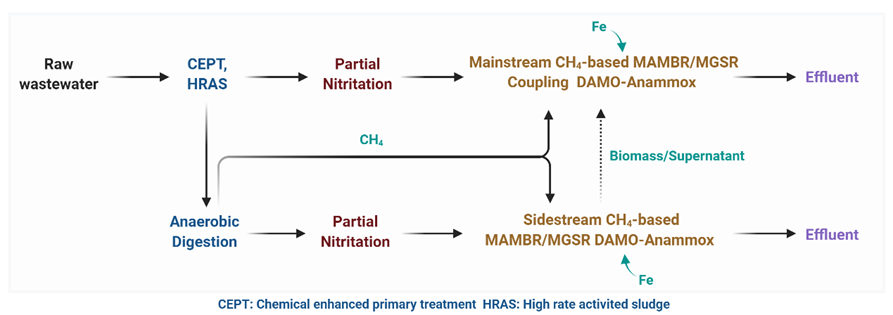Enhancing integrated DAMO-anammox processes for nitrogen and methane removal
First published in Water e-Journal Vol 7 No 1 2022.
DOWNLOAD THE PAPER
Abstract
Beyond the limits of human sight is an unseen universe that only microscopes can explore. In wastewater, it’s full of microorganisms like bacteria. Alone bacteria may play a negligible role, but together could play a critical role. In our work, we employed three different bacteria to simultaneously convert ammonium, methane, and oxidized nitrogen species (nitrite and nitrate) to harmless N2 and CO2. They were DAMO (denitrifying anaerobic methane oxidation) bacteria, DAMO archaea, and Anammox (anaerobic ammonium oxidation) bacteria, forming a dynamic network inside the wastewater with collaborative and competitive interactions. Researchers did a great deal of work to crack their mysteries and find an interesting relationship among them: One’s poop is another’s food, fulfilling the nitrogen and carbon cycle, and named it DAMO-Anammox process. However, culturing DAMO-Anammox microorganisms has been a challenge due to their extremely slow growth rate, low metabolic activity, thus poor nitrogen and methane removal rate. Therefore, we aim to shorten the doubling time, enhance the metabolic activity, and accelerate nitrogen and methane removal rate by addition iron. As common water and wastewater treatment chemicals, iron can be added into the bioreactor to enhance the microbial activity during the enrichment stage, and to maintain or enhance the nitrogen and methane removal performance during the long-term operation. This process would achieve energy-positive in wastewater treatment plants (WWTPs) with the potential to be applied widely at full scale.
 Figure 1. Conceptual flow diagram of an energy-positive wastewater treatment plant based on the integrated DAMO-Anammox system
Figure 1. Conceptual flow diagram of an energy-positive wastewater treatment plant based on the integrated DAMO-Anammox system
